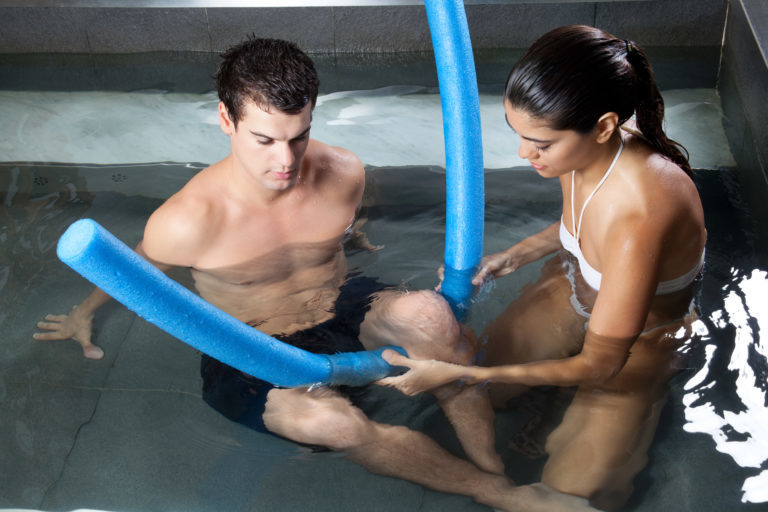
Aquatherapy goes by many names – you may have heard it called hydrotherapy or aquatic therapy. In a nutshell, Aquatherapy means “moving in water”, and it is being recommended by physicians and surgeons as part of treatment for more and more conditions, ranging from osteoarthritis and chronic pain, to knee replacement and back surgery. But what exactly is different about moving in the water? What makes moving in the water superior to moving on land, or say, exercising in a gym? Our Physiotherapist Stephanie Aubin outlines a few factors that make moving and exercising in water unique.
First, we have the benefit of fine-tuning of the exercise to the individual in water. The water is an excellent place to begin resistance training after an injury or surgery, when you might not know how much weight with which to begin. Conveniently, the water offers resistance in relation to the intensity with which you execute a movement. So you can start with slow movements with little resistance (for example open fingers rather than closed fingers) and then increase the intensity from there.
Another factor unique to exercise in water: we are given a relative respite from gravity. If you’ve ever had an injury that has made it challenging to walk, you know that feeling of relief as you enter a pool and can take some of the weight off. The buoyancy of our bodies in water is an important part of why we can execute movements and exercises that may not be available to us outside of the water. For persons with arthritic and other joint pain, this temporary relief from gravity has a dramatic impact on how comfortable it is for them to exercise, and therefore the frequency and intensity with which they will exercise.
The water is also an excellent place to train balance. The buoyancy we experience in water may make certain balance exercises easier and alleviate some of the fear of falling. Alleviating this risk allows us to move more confidently and challenge ourselves. In addition, the resistance offered by the water and the currents we might create by moving actually challenge our balance, making it an excellent training tool.
One of the lesser known benefits is the compressive aspect of submersion in water. Because the deeper the body part, the more compression, it can be excellent tool for lower body swelling, moving extra fluid away from the periphery and up. Again, not as easily done on land where fluid is mostly facing an uphill battle to move out of the feet.
An additional benefit of the compressive property of water is the impact it has on our breathing. The compression of the water actually cues us to use our diaphragm and practice ‘belly breathing’, giving our accessory breathing muscles in the chest, neck, and shoulders a break.
The bottom line is movement. The beneficial property of moving has to do with what is called proprioception. Proprioception describes a body part’s ability to know where it is in space. In water, we get constant feedback all over our skin as the water makes contact. As our brain processes the sensation, we are getting constant updates on where our body is in space. This enhanced proprioception can be a powerful tool in allowing us to feel safe in our bodies, and therefore allowing us to move.
Together, these properties make it a place where we feel safe to move, train and breathe, and that is valuable. Our bodies benefit tremendously by all the information the brain receives when we move. When this brain rewiring is challenging to achieve on land, we can turn to the water!
To find out if our one-on-one aqua-therapy program in Burlington is right for you please stop by the clinic for a chat, We have been having tremendous success treating a wide variety of acute and chronic injuries under water. All our visits are designed and carried out by a registered physiotherapist who has specialized in aquatics based rehabilitation.
References:
De Groot, L., Gross, R., Twynham, J., & Leitch, D. WaterART Post Aquatic Rehabilitation for General Populations Manual
Ingraham, P. Get in the Pool for Pain. Retrieved from: https://www.painscience.com/articles/aquatic-therapy.php



